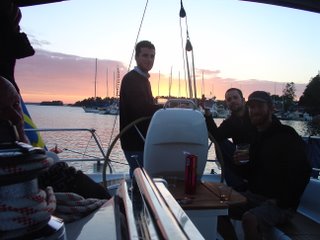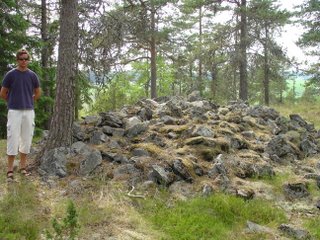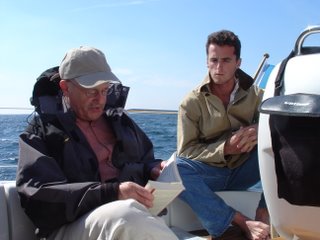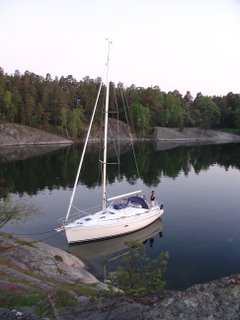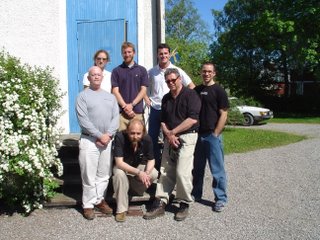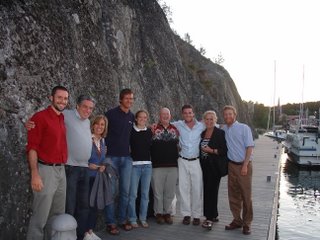June 25, 2006
Ship’s Log
June 25, 2006
Departure Location: Lappo, Aland Islands
Departure Time: 9:45 hours
Distance Traveled: 47.69 nautical miles
Arrival Location: Mattskar, Aland Islands
Arrival Time: 18:11 hours
Weather: Threatening skies, but no storms until 2 AM, beautiful sunset
Personal Comments:
The crew woke this morning with Scrabble on the brain. Over the last two days the game has taken its place as a staple activity on board the boat, and has become an intensely competitive endeavour. Recently Caleb has excelled as the most noteworthy player, scoring epic turns that have been known to grace the high 70’s. Having no dictionary on board, we have appointed Bill as the official master of the English language, giving him the power to approve or disapprove a word from play.
Today we made such good time that we reached our night harbor by midday and so decided to press on. Late in the afternoon we made the decision to sail towards a protected cove for the night and drop anchor. Surrounded by gently sloping rocks that extend out under shallow water on three sides, we were unable to secure the boat from shore and were forced to drop anchor in the middle of the cove. As a side note, it is customary in this part of the world to moor at the very edge of the shore with two bow lines attached land and a stern line attached to an anchor or mooring (this configuration can be seen in a picture of the boat that was posted earlier). The dock and piling system is almost unheard of here.
Research Comments:
The seas we have sailed between Applö and Mattskär have further resonances with the Iliad by Vinci’s account (p. 165) than just with Apollo’s cult. Just as central a deity to that poem as Apollo is Achilles’ mother, the sea-nymph Thetis, who lives with many other Nereids, sea-nymphs who are daughters of Nereus, the Old Man of the Sea. She always appears at crucial turns in the plot: Book One (ll. 348ff.), when Achilles goes down to the sea to bewail his humiliation at the hands of Agamemnon; Book Eighteen (ll. 35ff), when his dreadful cry at the death of Patroclus is heard by her and the other Nereids in the offshore depths; Book Twenty-Four (ll. 77ff.), when the Olympians decide to send Iris, the rainbow messenger goddess, down into Thetis’ sea-cave to ask her to tell her son that it is their will that he restore Hector’s body to Priam. In this last passage the narrator is quite explicit about the location of Thetis’ sea-cave: it is “midway between Samos and rocky Imbros.” Samos (specifically “Thracian Samos,” or Samothrace”) is located by Vinci at Ordnallsklint, the mountain from which we, like Poseidon, could see far to the east over many of the islands of the Troad, and today we had the satisfaction of sailing past it and photographing its whole outline from the north. This was after we had crossed from Lappo to the main set of Aland islands by traversing the stretch of relatively open sea called Delet, a name Vinci identifies with Delois (again, it is exactly the same root, ‘-et’ being a standard nominal termination in modern Swedish and ‘-os’ in ancient Greek).
What was perhaps the most thrilling part of our sailing was to think that this whole tract of sea contained, somewhere in its depths between the Troad and Ordnallsklint, the very sea cave where Thetis lived with her nymphs. Nowhere is the tragic music of Homeric verse so pure and moving as when the poet recites the names of the sea-nymphs who are sitting around Thetis at the time she hears the news of Patroclus’ death and immediately join her in lamenting it (18.35-51). Each of their thirty names has something to do with the sea (Robert Fagles’ Iliad beautifully translates the meaning of each name into English), such as Glauke (Sea-Green), Speio (Sea-Cave), Halie (Marine). For fifteen lines the narrative is suspended the pure music of these names. And the Nereids who bore them were all in the depths beneath us as we sailed.

